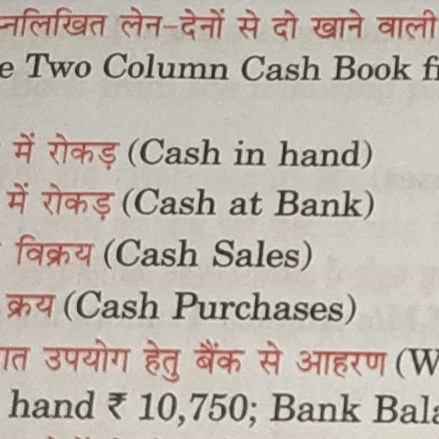Commerce Exam > Commerce Questions > Cash and Cash Equivalents do not include_____...
Start Learning for Free
Cash and Cash Equivalents do not include_____
- a)Cash in hand
- b)Cheques in hand
- c)Cash at bank
- d)Inventories
Correct answer is option 'D'. Can you explain this answer?
Verified Answer
Cash and Cash Equivalents do not include_____a)Cash in handb)Cheques i...
Cash and Cash Equivalents do not include inventories but following items are part of cash and cash equivalents:
•Cheques in hand
•Cash in hand
•Cash at bank
•Cheques in hand
•Cash in hand
•Cash at bank
Most Upvoted Answer
Cash and Cash Equivalents do not include_____a)Cash in handb)Cheques i...

Free Test
FREE
| Start Free Test |
Community Answer
Cash and Cash Equivalents do not include_____a)Cash in handb)Cheques i...
Cash and Cash Equivalents are highly liquid assets that can be easily converted into cash within a short period of time, typically within three months. They are considered to be the most liquid form of assets and are crucial for the day-to-day operations of a business. Cash and Cash Equivalents include cash in hand, cheques in hand, and cash at bank. However, they do not include inventories.
Cash in hand:
Cash in hand refers to the physical currency that a business holds. It includes banknotes and coins that are readily available for use in transactions. Cash in hand is an important component of a company's cash management system as it allows for immediate payment of expenses and other financial obligations.
Cheques in hand:
Cheques in hand are written orders to pay a specified amount of money from a bank account. They are issued by a company but have not yet been presented to the bank for payment. Cheques in hand are considered as cash equivalents because they can be easily converted into cash once they are deposited and cleared by the bank.
Cash at bank:
Cash at bank refers to the funds that a company holds in its bank accounts. It includes both current accounts and savings accounts. Cash at bank is highly liquid and can be easily accessed by the company for its operational needs. It provides a secure and convenient way of storing and managing funds. Cash at bank also includes any short-term investments that can be readily converted into cash, such as money market funds.
Inventories:
Inventories, on the other hand, are not considered as cash or cash equivalents. They are assets held by a company for sale in the ordinary course of business or for use in the production of goods or services. Inventories include raw materials, work-in-progress, and finished goods. While inventories have value, they are not readily convertible into cash and therefore do not fall under the category of cash and cash equivalents.
In conclusion, cash and cash equivalents include cash in hand, cheques in hand, and cash at bank. These assets are highly liquid and can be easily converted into cash. However, inventories are not considered as cash or cash equivalents as they are not readily convertible into cash.
Cash in hand:
Cash in hand refers to the physical currency that a business holds. It includes banknotes and coins that are readily available for use in transactions. Cash in hand is an important component of a company's cash management system as it allows for immediate payment of expenses and other financial obligations.
Cheques in hand:
Cheques in hand are written orders to pay a specified amount of money from a bank account. They are issued by a company but have not yet been presented to the bank for payment. Cheques in hand are considered as cash equivalents because they can be easily converted into cash once they are deposited and cleared by the bank.
Cash at bank:
Cash at bank refers to the funds that a company holds in its bank accounts. It includes both current accounts and savings accounts. Cash at bank is highly liquid and can be easily accessed by the company for its operational needs. It provides a secure and convenient way of storing and managing funds. Cash at bank also includes any short-term investments that can be readily converted into cash, such as money market funds.
Inventories:
Inventories, on the other hand, are not considered as cash or cash equivalents. They are assets held by a company for sale in the ordinary course of business or for use in the production of goods or services. Inventories include raw materials, work-in-progress, and finished goods. While inventories have value, they are not readily convertible into cash and therefore do not fall under the category of cash and cash equivalents.
In conclusion, cash and cash equivalents include cash in hand, cheques in hand, and cash at bank. These assets are highly liquid and can be easily converted into cash. However, inventories are not considered as cash or cash equivalents as they are not readily convertible into cash.

|
Explore Courses for Commerce exam
|

|
Question Description
Cash and Cash Equivalents do not include_____a)Cash in handb)Cheques in handc)Cash at bankd)InventoriesCorrect answer is option 'D'. Can you explain this answer? for Commerce 2025 is part of Commerce preparation. The Question and answers have been prepared according to the Commerce exam syllabus. Information about Cash and Cash Equivalents do not include_____a)Cash in handb)Cheques in handc)Cash at bankd)InventoriesCorrect answer is option 'D'. Can you explain this answer? covers all topics & solutions for Commerce 2025 Exam. Find important definitions, questions, meanings, examples, exercises and tests below for Cash and Cash Equivalents do not include_____a)Cash in handb)Cheques in handc)Cash at bankd)InventoriesCorrect answer is option 'D'. Can you explain this answer?.
Cash and Cash Equivalents do not include_____a)Cash in handb)Cheques in handc)Cash at bankd)InventoriesCorrect answer is option 'D'. Can you explain this answer? for Commerce 2025 is part of Commerce preparation. The Question and answers have been prepared according to the Commerce exam syllabus. Information about Cash and Cash Equivalents do not include_____a)Cash in handb)Cheques in handc)Cash at bankd)InventoriesCorrect answer is option 'D'. Can you explain this answer? covers all topics & solutions for Commerce 2025 Exam. Find important definitions, questions, meanings, examples, exercises and tests below for Cash and Cash Equivalents do not include_____a)Cash in handb)Cheques in handc)Cash at bankd)InventoriesCorrect answer is option 'D'. Can you explain this answer?.
Solutions for Cash and Cash Equivalents do not include_____a)Cash in handb)Cheques in handc)Cash at bankd)InventoriesCorrect answer is option 'D'. Can you explain this answer? in English & in Hindi are available as part of our courses for Commerce.
Download more important topics, notes, lectures and mock test series for Commerce Exam by signing up for free.
Here you can find the meaning of Cash and Cash Equivalents do not include_____a)Cash in handb)Cheques in handc)Cash at bankd)InventoriesCorrect answer is option 'D'. Can you explain this answer? defined & explained in the simplest way possible. Besides giving the explanation of
Cash and Cash Equivalents do not include_____a)Cash in handb)Cheques in handc)Cash at bankd)InventoriesCorrect answer is option 'D'. Can you explain this answer?, a detailed solution for Cash and Cash Equivalents do not include_____a)Cash in handb)Cheques in handc)Cash at bankd)InventoriesCorrect answer is option 'D'. Can you explain this answer? has been provided alongside types of Cash and Cash Equivalents do not include_____a)Cash in handb)Cheques in handc)Cash at bankd)InventoriesCorrect answer is option 'D'. Can you explain this answer? theory, EduRev gives you an
ample number of questions to practice Cash and Cash Equivalents do not include_____a)Cash in handb)Cheques in handc)Cash at bankd)InventoriesCorrect answer is option 'D'. Can you explain this answer? tests, examples and also practice Commerce tests.

|
Explore Courses for Commerce exam
|

|
Signup for Free!
Signup to see your scores go up within 7 days! Learn & Practice with 1000+ FREE Notes, Videos & Tests.


















